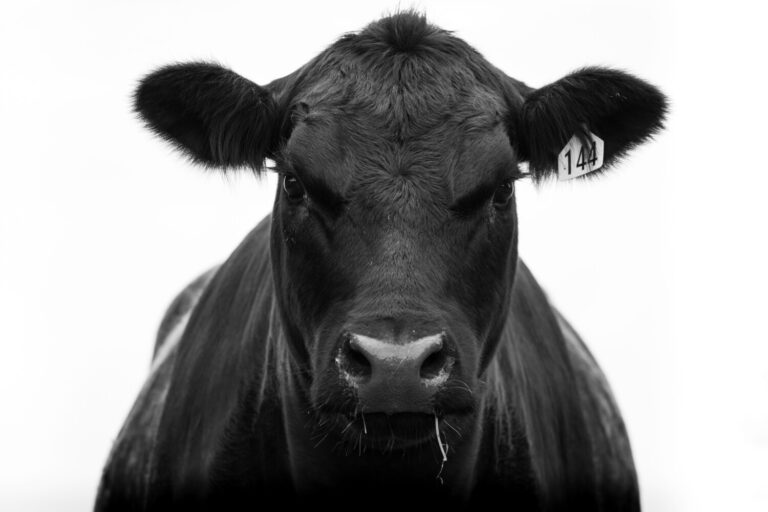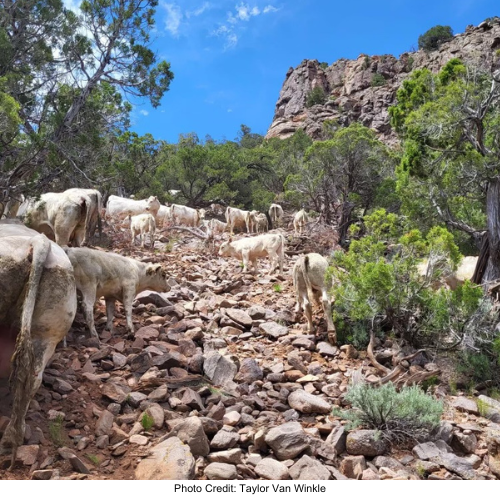
Keeping Your Own Replacements vs. Buying
March 2024
Dean Van Winkle came back to the family operation after graduating from Kansas State University and continued to build upon the purebred Charolais operation he established as a teen. Van Winkle Ranch, especially compared to the home operations of many of his Midwest classmates, is unique in size, elevation, and the type of cow necessary to thrive. In cooperation with his parents — Harold and Janie — Dean and his wife, Tayler, also run a commercial cowherd, sell purebred bulls and help supply the family’s freezer beef business. While he said there are many moving parts, it gives him several options to find the right fit for every bull, cow, heifer and steer.
The Year of the Replacement
Van Winkle has specific needs when it comes to replacement cattle and after an exceptionally dry year forced a reduction in his cow numbers, this year ushered in an unusually high number of replacements, both raised and purchased. As producers rebuild their numbers in other areas of the country as well and the national cowherd is at record low numbers, demand is high. While that has certainly driven up the price for replacements, it has also bolstered the market for bulls.
Van Winkle Ranch is in Western Colorado in Mesa County, and their range varies in elevation from about 4,000 ft. (1,219 m) to over 10,500 ft. (3,200 m). At this elevation, Van Winkle said cattle must be able to travel long distances in steep and rocky terrain, making feet and legs high on his priority list for replacement stock.

“Our cattle have to travel, and they spend a lot of their life traveling, whether it’s on a truck or afoot,” he said. “Our summer country is 50,000 acres and they walk to the mountain, and they walk back. We do truck them about 20 miles (32 km) to get them there before they walk up the hill. It’s pretty steep, pretty nasty country and it’s hard for us to buy heifers or bulls that can withstand that and have the structural integrity and the feet that will handle that.”
Structural Integrity
Van Winkle said as they began to identify replacements to build their herd numbers back to pre-drought levels, they found most cattle had never been turned out on pastures larger than a section, making the experience of being a range cow in the high country challenging. He said as they purchased females, the suitable purebreds could run as a part of that operation, females suitable to thrive as range cows could run as part of the commercial operation, and the individuals that could do neither, could be fed for the direct-to-consumer beef business.
“What we run into with feet and legs, especially with replacements we purchase, their feet shape may be correct, and structurally they might be correct, but when they get turned out and start having to walk all the time, you can see the holes in them pretty quickly,” he said. “It’s been more evident to me this spring than it has been for a long time because we’ve brought so many cattle in that weren’t raised here.”
Unique Needs
With any operation that runs cows at elevation, Pulmonary Arterial Pressure or PAP scores become a consideration to avoid livestock predisposed to developing congestive heart failure above 6,800 ft (2,100 m). Van Winkle said they PAP test all their bulls and heifers, which becomes a major factor to consider when purchasing replacements. This, and the ability to travel and graze huge pastures and forest allotments, can lend a major advantage to raising their own replacements or purchasing from similar operations.
The first calf heifers are AI bred to calving ease Red Angus bulls with the intention of retention.
“For us, we need a red bull that has some maternal characteristics to make those ‘mellow yellow’ females to go back into the commercial herd,” he said. “Finding bulls that fit that need can be pretty tough so when we do find those bulls, we AI a couple hundred head to them.”
Selling Replacements
On the purebred side of the operation, Van Winkle began raising bulls for retention in their own operation and when they raised an excess of what they could utilize themselves, they began offering bulls for sale.
“If I wouldn’t use a bull on our cows at home, there’s no reason he should be in that sale,” he said. “I’m a firm believer in that. I can’t sell something to someone, even if they aren’t running in harsh conditions like we are where the cattle truly have to work for a living, that won’t hold up.”
He said the later born bulls that don’t have the age advantage to fit the sale offering are retained for use on their own commercial cows. Those bulls have the same performance and genetics, but lacked the size and age on sale day, giving them one more outlet to find the right fit for different cattle.
The Big Picture
The diversity of the ranch operation, he said, offers versatility and a suitable fit for different types of cattle to some extent. This lessens the financial risk in purchasing replacements and allows them also to offer bulls for sale to other operations that don’t necessarily mirror their own.
“That’s something I kept in the back of my mind as we were purchasing replacements this winter,” he said. “If push comes to shove, we can at least recoup some investment in the meat business if a replacement doesn’t work for us.”
Alternately, the beef business also provided financial flexibility to allow Van Winkle to retain more heifers which made the feeder calf income significantly less. He said while his standards for replacements are high and unique, keeping an eye on the big picture and building some flexibility into the operation has allowed him to rebuild herd numbers with cattle in the right situation.
Resources
Van Winkle said most of their bull customers are local and the majority of replacement females they purchase for the commercial herd are purchased locally. He depends on his veterinarian not only for PAP testing and advising his vaccination protocols, but also for supporting them as they transition purchased replacements into their operation and preparing bulls for sale.
Information noted above was gathered from a third party who was advised his/her experience might be featured in marketing materials. This article contains third-party observations, advice or experiences that do not necessarily reflect the opinions of Vermeer Corporation, its affiliates or its dealers.
Vermeer and the Vermeer logo are trademarks of Vermeer Manufacturing Company in the U.S. and/or other countries.
© 2024 Vermeer Corporation. All Rights Reserved.

